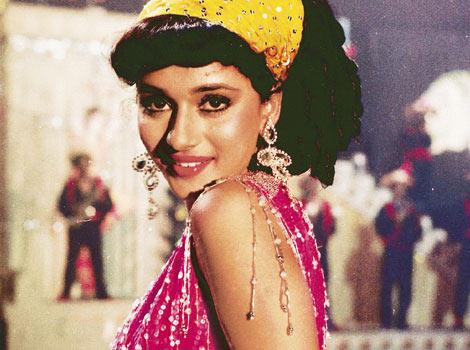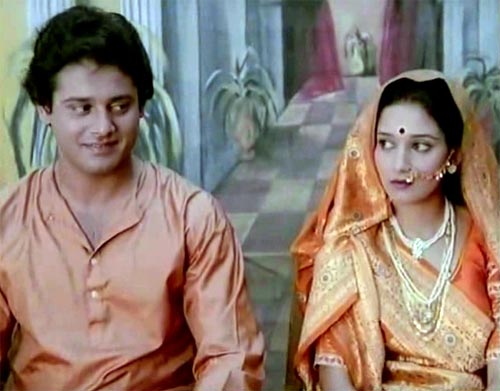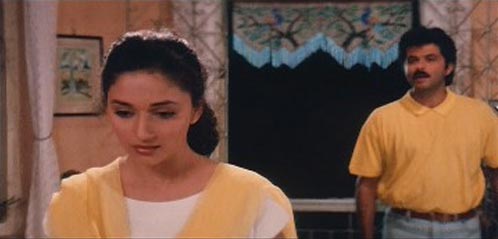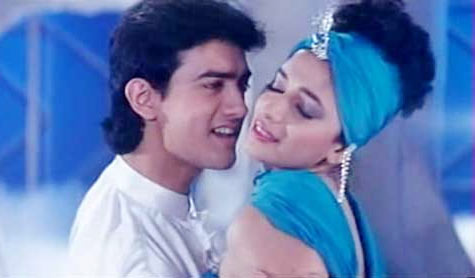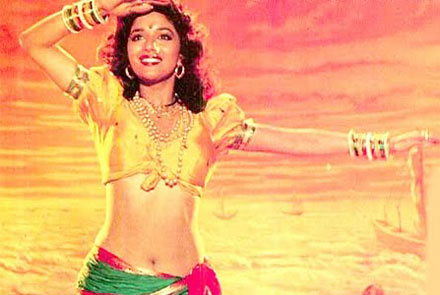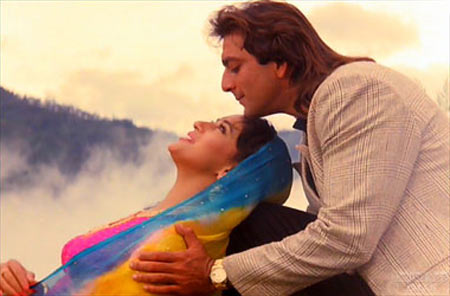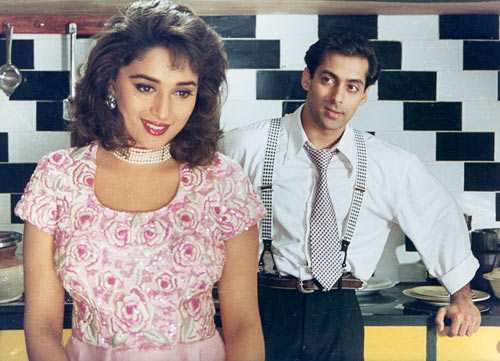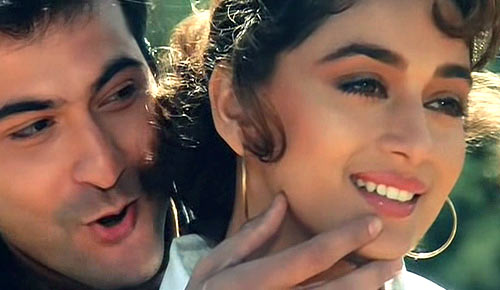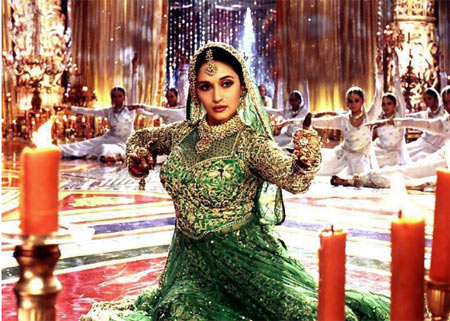 | « Back to article | Print this article |
Madhuri Dixit: Had I really done all those films?
As Madhuri Dixit celebrates her birthday, May 15, we understand the rather mysterious actress much better through a revealing interview that appears in a new book, Mother Maiden Mistress: Women in Hindi Cinema 1950-2010.
Written by Bhawana Somaaya, Jigna Kothari and Supriya Madangarli, Mother Maiden Mistress documents the cinematic journeys legendary actresses like Waheeda Rahman, Asha Parekh, Hema Malini, Shabana Azmi, Madhuri Dixit and Rani Mukerji have taken through the years through a rich repertoire of roles.
Madhuri Dixit was a teenager when their neighbour Govind Moonis, working with Rajshri Productions, was on the lookout for a new face for Abodh. He discussed the idea with the Dixits and they agreed since they had known Govind for years.
Madhuri agreed because she loved dancing and believed that the film would open opportunities for her to perform Kathak on a bigger platform.
Abodh sank without a trace. In the meantime, Madhuri, while completing her graduation, signed up for many forgettable films like Awara Baap and Swati in which she played second lead to Meenakshi Seshadri.
She was shooting for Manav Hatya with Rajan Sippy in Kashmir when her hairdresser Khatoon -- who had been with Aruna Irani for many years -- took her to meet Subhash Ghai while he was shooting for Karma at a nearby location.
Subhash Ghai recognised her potential as a star, but before he could introduce her under his production, he needed to bail her out of her B-grade banner history.
Ghai convinced producers Boney Kapoor and Pradeep Sharma to sign a film with her and the trio launched her in a magnificent ad campaign in Hindi cinema's oldest film weekly Screen which revealed her face bit by bit every week so by the end of the month everybody was curious about Subhash Ghai's new heroine in Uttar Dakshin (1987).
Come Tezaab (1988) and Ram Lakhan, Parinda and Prem Pratigya (1989), and a star was born!
Excerpted from Mother Maiden Mistress Women in Hindi Cinema, 1950-2010, by Bhawana Somaaya, Jigna Kothari and Supriya Madangarli, HarperCollins Publishers India, 2012, Rs 299, with the publisher's permission.
Wish Madhuri Dixit a happy birthday!
'I realised it was not going to be easy playing Mohini'
Says Madhuri Dixit:
"When N Chandra approached me for Tezaab, I said 'Yes' because I loved Mohini and admired her strength and spirit to face adversities as a challenge. When betrayed, she tells the truth without mincing words to her father and her boyfriend. It was only when I went to the sets that I realised it was not going to be easy playing Mohini. She has a volatile relationship with her father.
I had never heard lines like 'Buddhe ko mirchi lagi ...' and it took me forty retakes to speak the word 'laundiyaan' and it was still not the way the director wanted, but Chandraji was extremely patient and tutored me at every stage.
He spoke to me extensively before we shot the 'Main aap ki dukaan hoon' ('I am nothing but a business venture for you') scene with Anupam (Kher), and I remember there was silence on the set for a long time.
Another difficult scene was when Mohini is kidnapped and turns hysterical. I am by nature a little withdrawn and wasn't able to do it, so Chandraji enacted the scene for me; watching him, I found the confidence to portray the scene my way.
Tezaab was an important film for me in terms of shedding inhibitions, both as an actor and as a dancer. I knew I was a good dancer, but whenever I watched myself on screen I always felt I wasn't giving my best. I was holding back.
Then I met choreographer Saroj Khan and she made me go through vigorous rehearsals of ten hours for fifteen days; so by the time we began shooting Ek do teen ... I was perfect with the steps and now only needed to work on the expressions.
Sarojji introduced me to the language of cinema -- how to sway and smile during a step.
I play Radha Shastri, a simple village belle in love with a comman in Ram Lakhan. My father has fixed my marriage with someone else and my boyfriend is missing, so on Ramnavmi day, when his elder brother and partner visit our home for the festivities, I complain to him about his younger brother in the disguise of a bhajan, 0 Ramji...
I was all ready and waiting on the sets when Subhashji asked Saroj Khan to demonstrate the actions. She had choreographed it like a regular film song, but Ghai disapproved of it. He explained that Radha was a village girl singing a bhajan in the presence of her brother-in-law.
That is the first time I realised that though songs and dances are shot in isolation, they have to be in sync with the character.
'Shooting my first rain dance was a nightmare'
Paro in Parinda is like a breath of fresh air where everybody is angry. She is a messenger of peace amidst violence and riots.
It was a painstakingly shot film and Vinod Chopra laboured over every frame to make it magical.
The pigeon scenes were simply magnificent. Anil and I die in a bedroom scene in the last sequence of the film.
I was reluctant to do a lovemaking scene after all the controversies that chased me in Dayavan, so Vinod shot the scene with someone else and showed it to me. He explained that it would be very aesthetic and far from titillating.
I trusted him and he did not let me down. I was learning to drop my defences as a professional and in the process courting opportunities to excel as an artiste.
Those days we worked on multiple films simultaneously. Some of them -- such as Jeevan Ek Sanghursh where I play Miss Asia -- are a blur.
I accepted Izzatdaar because I didn't want to miss the opportunity of working with Dilip Kumar.
Similarly, Maha-Sangram was a spontaneous decision. Vinod Khanna was making a comeback after his Rajneesh phase and Dimple Kapadia had opted out of the project at the last minute. Producer Nitin Manmohan and director Mukul Anand were in serious trouble because their set was ready and they didn't want to lose Vinod Khanna's dates.
They approached my manager and Rikkuji decided to bail them out. I had no dates, but since Rikkuji had made a commitment, I shot the entire film in a night shift. My character Jhumri helps the hero find the killer of his younger brother -- not a great role, but I was well presented.
I had a great song -- my first rain dance -- but shooting it was a nightmare. It was extremely cold and when drenched, the embroidered ghagra became extremely heavy. Chinni Prakash was the choreographer, and no matter how hard I tried, he wanted more aggressive movements and expressions from me, and by the time we finished, I was completely drained.
'My fans were outraged by the kiss scene in Dil'
Dil was about following the heart. In the film, Aamir Khan and I have our share of disagreements, fall in love and get married despite parental opposition.
Dil had great music, a dramatic story, and evoked multiple controversies. My fans were outraged by the kiss scene, and critics objected to offensive lyrics like 'Khambhe jaisi khadi hai, ladki hai ya chadi hai'.
Hindu religious groups were outraged because Aamir and I walk around the fire wearing shoes, and activists protested to the rape scene.
Dil is probably the first film where the heroine accuses the hero of rape (usually such tricks are attributed to negative characters) and the hero teaches her how wrong it is to make a false allegation pertaining to something as serious as rape.
Madhu Mehra was a spunky character and Dil a super success and the beginning of my long association with the banner.
Producer Ajit Parshotam offered Aamir and me Deewana Mujh Sa Nahin which was a remake of a superhit English film, and both of us loved the concept and agreed instantly.
Aamir plays an overconfident photographer in the agency where I work as a model. He assumes I'm in love with him and I'm outraged by his audacity.
While shooting this film directed by Nageshwara Rao, we thought we had an ace up our sleeve, but the film sank without a trace. It was my first lesson as an actor that one can never predict the mood of the audience till the film is released.
'Sailaab and Thanedaar are remembered because of the sizzling item numbers'
Sailaab and Thanedaar are remembered because of the sizzling item numbers.
Saroj Khan choreographed both these songs and pointed out that Humko... was the first instance where the mukhda is sung by the chorus and the antara by the heroine.
I arrived on the sets wearing a koli sari and my hair tied in a regular jooda with flowers.
Saroj Khan had one look at me and asked me to change my hair and costume. She said the song is about a young girl waiting for her beloved and had to be portrayed with a sense of abandon.
I was confused because I played a doctor in the film, but submitted to the costume designer who improvised the pallu from the shoulder to the waist and opened my hair up. They used a lot of fans in the background and Sarojji was very confident that no matter what the fate of the film, the dance would be a super hit.
It was.
All I remember about Thanedaar is the Janet Jackson dance number Tamma Tamma ... The dance involved vigorous movements and in those days, advanced knee pads were not available to protect a performer's knees as is the case today.
We had a long, elaborate sequence to be performed with props, and Sarojji was hell-bent on shooting it without cuts. We had endless rehearsals for the song, and Sanjay Dutt was particularly paranoid.
Despite our best efforts, on the day of the shoot, we were unable to okay any take because when you have four performers in sync and four props, something has to go wrong in every take and then you have to do it all over again.
We were shooting the dance forever and finally got it right in the fiftieth take, when nobody made a mistake and everyone heaved a sigh of relief!
The song generated a media buzz because it had a striking resemblance with Jumma Chumma ... of Hum, though both were choreographed and shot completely differently. The media went berserk, when the fact is that both were borrowed from the same English song.
'Producers were optimistic about my pairing with Anil Kapoor'
Some films are done as pair boosters. Producers were optimistic about my pairing with Anil Kapoor and we did Kishen Kanhaiya and Jamai Raja.
The former was a remake of Ram Aur Shyam/Seeta Aur Geeta and Anil and I played crazy film buffs. Anju is dramatic and theatrical, and enacts scenes while watching films until one day she meets her match in the form of Anil Kapoor.
In Jamai Raja, my mother Hema Malini tries her best to separate her daughter from her son-in-law, but does not succeed.
I'm afraid I have no memories of Khilaaf or Pratikar, but I have some memories of 100 Days, my first thriller.
As an actor, I was keen to try out different genres and was attracted to the story of a girl gifted with extrasensory perception.
One day, while playing tennis with her friend, Devi has a vision of her sister being shot to death by a man in a black raincoat. It was an interesting film where I suspect the killer is my husband Jackie Shroff and start spying on him. It was a bold theme but didn't fare well at the box office.
'After Tezaab and Dil, Saajan was an important turning point in my career'
I accepted Prahaar because I wanted to support Nana Patekar making his debut as a director. It was a cameo, but worth it for the experience of working with Dimple Kapadia.
Shirley is a gregarious, excitable character who transforms after a personal tragedy. I portrayed her as over-the-top in the initial scene in order to bring the contrast in the subsequent one.
The film offered just one performing scene, but it is a moment I'm proud of. It is a very quiet, poignant moment, and I was trembling when the director called 'cut'.
Women married to army men go through tragedies all the time and yet life goes on ... how unfair and cruel.
After Tezaab and Dil, Saajan was an important turning point in my career. Today I can confess that many well wishers advised me against doing this film.
One, because it was not produced by an A-grade banner and two, because the heroine chooses the handicapped hero over the other in the climax.
There was a lot of pressure by the distributors on the writer to change the ending. They insisted that Pooja should choose Salman over Sanjay Dutt, but writer Reema Rakeshnath stuck to her convictions and I trusted her instinct.
Every film has a destiny; this one most certainly did, and what made the film special was the climax.
I didn't realise it then, but looking back, Saajan was a strong statement about a woman's right to make choices. Pooja chooses the poet because the person matters more to her than his appearance.
I had grown up watching Prakash Mehra films and looked forward to Zindagi Ek Juaa, but times had changed and so had film-making.
Khel was my second film with Rakesh Roshan after Kishen Kanhaiya and my first full-length comedy.
When I was new to films, they said I resembled Suchitra Sen, Madhubala and Mala Sinha. I never got an opportunity to work with Sen or Madhubala, but played Mala Sinha's granddaughter Seema, who is a con woman.
The way the director adapts my song Ek baat maan lo tum... from a cabaret number to a bhajan was, I felt, what set the tone of the film.
We shot the entire film in one schedule in Nairobi and everybody was convinced that we had a winner in our hands. When we watched the film, however, something was amiss.
Rakeshji said something that day which I have never forgotten: that movie-making should never be a rushed job.
It is important to pause and ponder, because that gives you time to rectify your mistakes.
'I describe Beta as a settling of scores between Anil Kapoor and me'
After Uttar Dakshin, of which I have fond memories of Rajnikant talking to me in Marathi during the shoot, Prem Deewane was my third film with Subhash Ghai.
I essayed the role of a cop who plays cupid to young lovers, and wore a regular police uniform. Though romance was the main plot of the film, Shivangi Mehra represents the conflict and anguish of women officers in the police force.
I love Saraswati of Beta. She is gutsy and self-righteous, also spunky and sensuous. She does a Dhak dhak... and then takes over the reins of a joint family, proving that a woman can be a different person in different circumstances. She is tough with the wicked and kind to the helpless.
She is supportive of her spouse and irreverent towards her mother-in-law. When Indu Irani narrated the script to me, I had no doubt that I would play the role. That a superb actor like Aruna Irani would play my mother-in-law was a bonus.
I describe Beta as a settling of scores between Anil Kapoor and me. Anil was nasty to my mother in Jamai Raja and I returned the favour in Beta.
Jackie Shroff's secretary Mukul Agarwal had been trying to launch himself as a producer, but had not been successful. He wanted me to sign a film and I agreed on condition that he gets K Vishwanath to direct it. He did, and I allotted bulk dates for Sangeet.
I played a double role -- of mother Nirmala and daughter Sangita -- in the film. It did not do well, but the experience of working with K Vishwanath enriched me for life.
If Bapu Sir during Prem Pratigya taught me how to accentuate a close-up or improvise an ordinary scene with your body language, Vishwanath Sir taught me the language of cinema. He helped you connect with your characters in quietude, and this is apparent in the older Nirmala.
It is the story of an out-of-wedlock child, but is different from all other films one has watched because the women are dignified and without bitterness. It is a very special film for me because Vishwanath Sir introduced me to the philosophy of life.
'I am very proud of my song Choli ke peechey kya hai'
I did a cameo in Dharavi because Shabana Azmi said that my presence was important to the film. Playing a taxi driver, Om Puri dreams that one day Madhuri Dixit will travel by his taxi.
Director Sudhir Mishra wanted me to spoof myself. Om Puri considers me a part of his life and shares his everyday thoughts with my photograph.
The character reminded me of an outdoor shoot where a fan barged in and began talking to me like an old friend. I was startled initially, but felt sympathy for him too.
Dharavi is about the common man. I dressed in chiffons and spoke sweetly to Om Puri. It was interesting to play someone's fantasy because that is different from playing an actor in a film.
Ramesh Talwar had signed Rishi Kapoor and Sanjay Dutt for a love story to be shot in a hill station. I accepted Sahibaan because I had liked his Doosra Aadmi and Baseraa.
Dil Tera Aashiq was a reversal of Shammi Kapoor's Professor, Aansoo Bane Angaray my first film with Jeetendra and Phool a thanksgiving gesture.
Much before Subhash Ghai launched me, I was signed by Rajendra Kumar for a film called Naraaz, written by Salim Khan and to be directed by Mahesh Bhatt and starring Kumar Gaurav and me. We were all ready to go on the floors when Salim Khan and Mahesh Bhatt had a disagreement on the script and parted ways.
Years passed, I became successful, and Kumar Gaurav was going through a lean phase.
Rajendra Kumar wanted to relaunch Kumar Gaurav and wanted me in the film. Rikkuji advised that we should do the film and the result was Phool.
When Subhash Ghai offered me Khalnayak, he said, 'I'm offering you a role that you have not played so far. You have to dance, emote, do action and also reform the villain.'
At that time neither Subhashji nor I were aware of the social interpretations; it was only later that I was made conscious of how Sita puts her life in danger to save Ram.
It is the only instance where a heroine goes to save the hero and in the process reforms Ravan.
Khalnayak established my status as a star. Interestingly, the feminists who applauded Ganga were angry with me for dancing to Choli ke peechey kya hai ... I was unapologetic.
It is a dance I'm proud of. It is beautifully shot, choreographed with great music, and has fabulous costumes.
Once again, Saroj Khan and I worked extremely hard on intricate folk steps and movements. I was fed up of dancing to disco tunes and enjoyed every moment of the picturiSation.
'I chose Anjaam over Darr'
I was offered Darr by Yash Chopra and Anjaam by Rahul Rawail at the same time. Both had the same story about obsessed lovers and both starred Shah Rukh Khan.
After much deliberation, I chose Anjaam over Darr because Darr is from the hero's perspective while Anjaam from the heroine's.
The film has Shivangi Chopra, an airhostess, being stalked by an unstable man. The conservatives were shocked because I portrayed her as very ruthless, almost sadistic, but I agreed with her and just loved the way the climax was shot.
Sooraj Barjatya called to say he wanted four hours of narration for Hum Aapke Hain Koun ...! Those were days when I was shooting double shifts and it took weeks before I could submit to a long sitting.
He read out every single scene and dialogue, every song, and by the end of the session, I was both happy and sad! Happy because I wanted to do the film, and sad because I had no dates. We somehow managed the dates and shooting the film was paradise on earth.
The film portrays goodness in life, and all the characters are noble. Nisha is an ideal daughter, sister and beloved and, strangely, not boring. She is naughty and flirtatious, and responsible when there is a crisis. My fans in India and abroad went crazy over my costumes, particularly the purple sari that I wore in Didi tera devar... which became mandatory at every wedding.
Strangely, the media has always criticised my sense of dressing and yet my costumes in films are the most imitated; so I have learnt to ignore all the negative things said about me.
Yaraana made a statement against abuse in relationships but unfortunately two more films on the same subject, Agni Sakshi and Daraar, were released at the same time and that didn't go well with the audience.
I think the film did not work because Lalita is neither married nor in love with the character played by Raj Babbar. She is economically independent and so there is no justification for her plight.
I admire Kajri in Prem Granth who goes through so many tragedies but does not lose her spirit. It was an R K banner film and we shot at R K Studios.
In between shots when I had the time I would walk on the pathway and wonder about the times when other R K heroines had done the same. It was a special feeling and I missed not being there in times of the legend himself.
'Shah Rukh Khan replaced Sunny Deol in Koyla'
Raja was mainstream masala -- a la Amar Akbar Anthony -- where I did comedy, tragedy and action. Indra Kumar included all kinds of genres in this film, his motive being to package wholesome entertainment, and he succeeded.
Every scene in the film is over the top and we were hysterical, laughing and shooting at the same time. It was my hat-trick with Indra Kumar as a director and the media went berserk calling me the female Amitabh Bachchan who can deliver absurdities and entertain.
Sunny Deol was to star in Koyla, but he was replaced with Shah Rukh Khan at the last minute. After Anjaam, we were yet again smeared in blood and joked with each other that we would do a happy, romantic film some day.
It was an interesting role where I'm married to a mute slave, but expected to serve as the Thakur's mistress. The subject sounded outrageous, but this happens in villages all the time. I was happy I was able to take a stand for these women.
Mohabbat was on the lines of Saajan where the heroine chooses her childhood friend Akshaye Khanna over the tycoon played by Sanjay.
Prakash Jha approached me to do Mrityudand and to be honest, I had never heard about him or watched any of his films. I agreed because I felt that if Shabana Azmi had agreed to do the film, the director must have some merit.
It told the story of small-town women who combine forces to fight the feudal system. It was the first time I wore no make-up in a film, dressed in simple seedha pallu saris and spoke in a regional dialect.
I had dramatic lines like 'Pati ho, parmeshwar banne ki koshish mat karo.' There was an uproar and men in small town UP and Bihar forbade their wives from watching the film in case they were inspired by my character and rebelled.
'I was petrified at the idea of dancing with Prabhu Deva'
Dil To Pagal Hai was originally titled Kiran.
The role was offered to me at the right time. Manish Malhotra dressed me sensuously and the chiffon suits became a fashion statement. Pooja is a dancer and I felt privileged to work with Shiamak Davar.
The film had a unique message -- that destiny takes us to our beloved but it's up to us to recognize the signals. I loved everything about the film -- the music, choreography, my character Pooja who believes that somebody special is made for her.
There is something attractive about Pooja's reserve. I feel closest to Pooja among all my characters because she is quiet, calm and restrained. I understand what goes on in her mind.
Every time Amitabh Bachchan and I came close to doing a film together, something went wrong. We shot four days of Bandhua with J P Dutta before it got stalled, and later Mukul Anand's Shanakht which though announced never took off.
Bade Miyan Chhote Miyan was done for the fun of it. I went to Mauritius with my family, shot for a few hours and had a holiday.
It is interesting how a star rises in her career on the basis of her repertoire in the previous decade. All of us had our decade to shine and some unforgettable roles trickled in the coming decade as well.
I accepted Gaja Gamini because there was no way I could refuse M F Husain. I think that was the reason all of us who acted in it did the film. Every frame is sheer poetry on celluloid. Sangeeta or Shakuntala are all forms of women drawn by Husainsaab. People thought he sketched me, but he never painted my face, it was always the form.
I am sympathetic towards Anjali in Pukar because she is an example of how one mistake can ruin everything for you. She is obsessive beyond reasoning and in her obsessive, vulnerable state, makes a blunder she lives to regret. It was nerve-wracking to portray her, and I collapsed when I got to know that I had to do a dance with Prabhu Deva.
I have never been scared of dancing with anybody in my career but was petrified at the idea of matching steps with him. I was later informed that he wasn't just dancing, but also choreographing. I wanted to run away, but he was very charming. He said he would choreograph steps that would suit my style, but once on the sets he was the master and made me do all the swaying, turning and bending steps he is famous for.
Que sera sera... was a huge challenge and I still cannot believe I was able to accomplish what he wanted.
'I had not played a courtesan ever in my career and if I had to, why not the best?'
When Rajkumar Santoshi offered me Lajja, he said I could choose the character I wanted.
I chose Janki, a small-town theatre artiste. I had never done a character like her before and fell in love with her attitude. There is a scene in the film where Manisha and I enter a paan-spitting competition. The scene was hilarious but got deleted.
Janki is feisty and fearless; when her boyfriend lets her down, she decides to have the baby nevertheless.
Lajja is not just about gender equations. It is about the different temperaments of women from different walks of life and how they make a difference to society.
When Sanjay Leela Bhansali offered me Devdas, I was married and settled in the US. I'm glad he thought of me as Chandramukhi and not Paro. I had not played a courtesan ever in my career and if I had to, why not the best?
Chandramukhi is an icon of love. She loves till she hurts.
Sanjay forbade me from watching Dilip Kumar's or any other version of Devdas and I obeyed because I didn't want to be influenced by Vyjayanthimala's interpretation of the character.
Shah Rukh Khan and I were coming together after Dil To Pagal Hai and a lot was expected from our chemistry. Sanjay wanted Birju Maharaj to compose the murjas and I was ecstatic that I would be working with my idol.
As a Kathak student, having Maharajji choreograph my dance was nothing short of a divine intervention.
When I look back, I wonder if it was indeed me who did those films. I think one just followed instructions and was truthful to the lines offered. The interpretations came much later when the films hit the theatres.
Excerpted from Mother Maiden Mistress Women in Hindi Cinema, 1950-2010, by Bhawana Somaaya, Jigna Kothari and Supriya Madangarli, HarperCollins Publishers India, 2012, Rs 299, with the publisher's permission.
